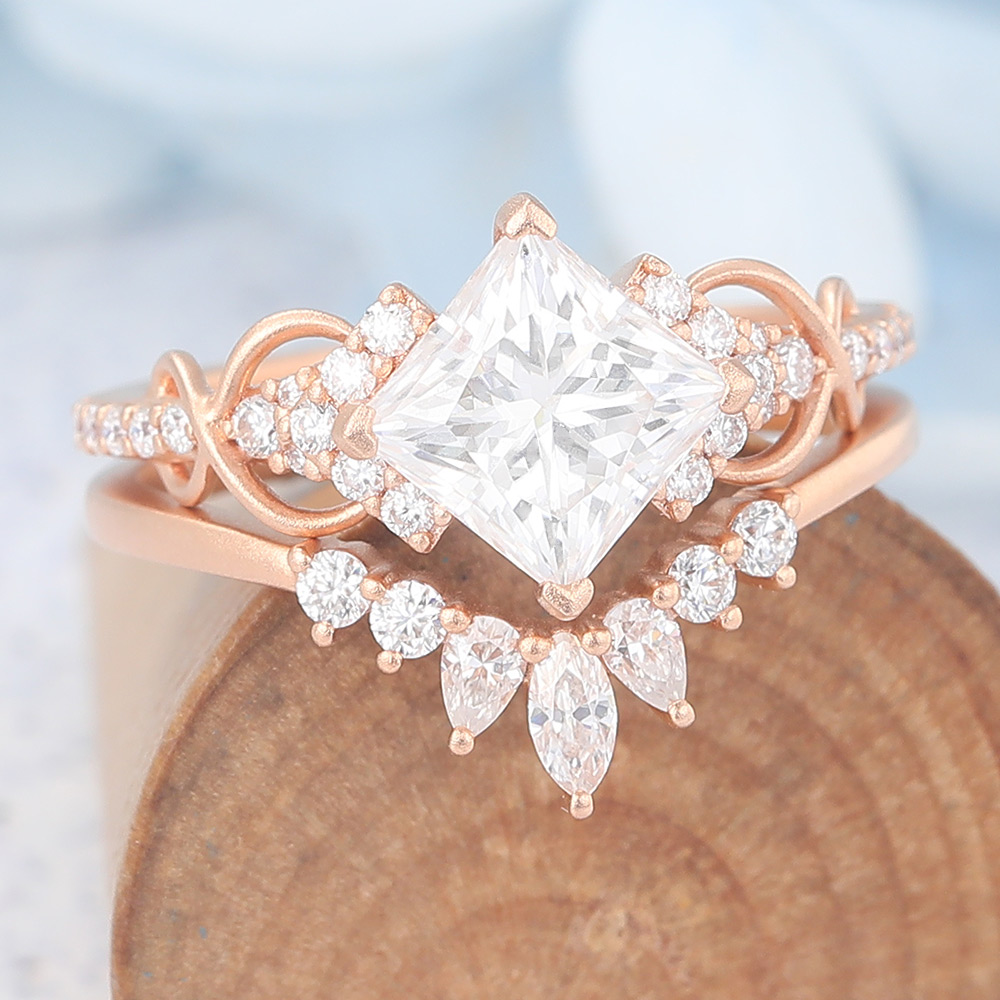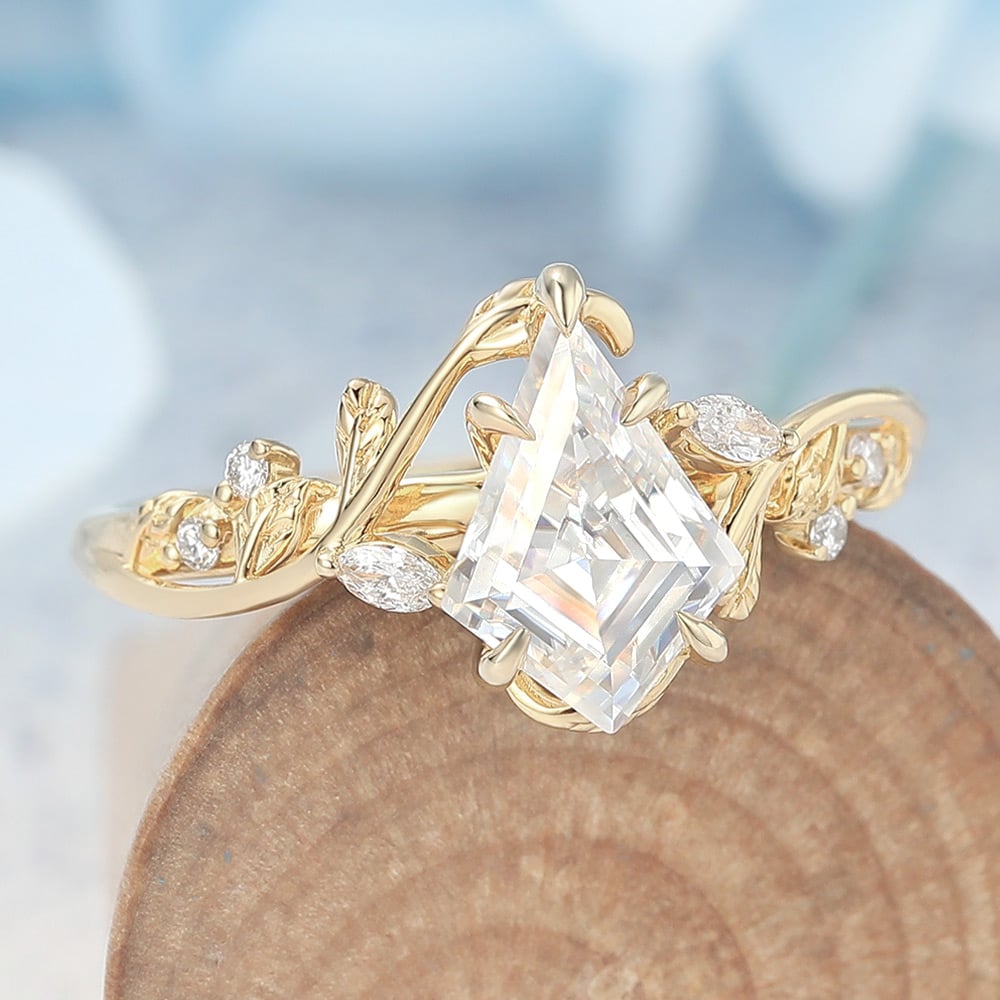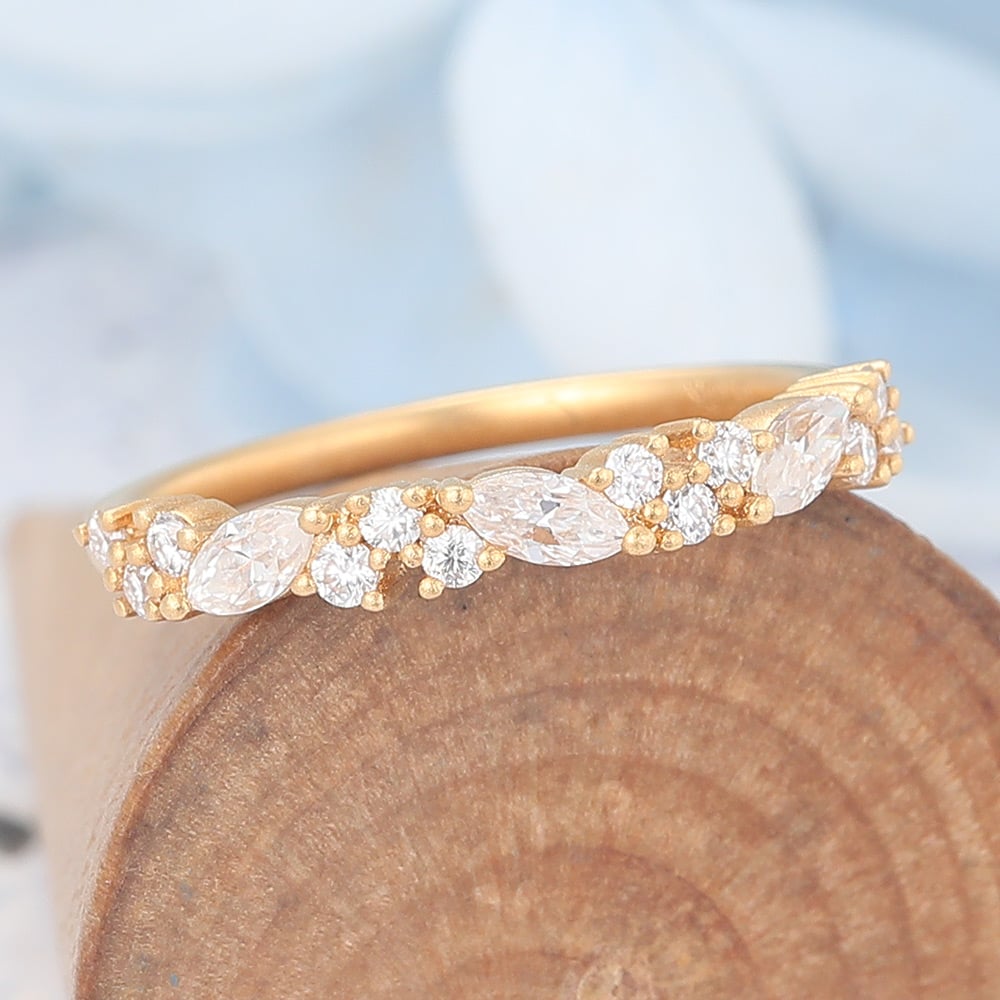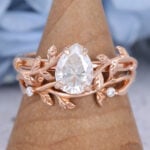Moissanite vs White Sapphire: Durability, Brilliance, Value, Meaning and Everyday Wear Compared
When it comes to sparkling gemstones, not all are created equal. Choosing between moissanite vs white sapphire means weighing more than just appearance—durability, brilliance, value, and even the meaning behind the stone all play a role. This comparison will guide you through the key differences, helping you find a gemstone that shines beautifully in both everyday life and special moments.
Definition and Composition
Moissanite
Moissanite is a gemstone composed of silicon carbide, originally discovered in meteorites but now mostly lab-created. Its stable crystal structure gives it exceptional durability and a brilliance that closely resembles diamonds. Available in a variety of sizes and cuts, moissanite is prized for its sparkle, toughness, and ethical sourcing.
White Sapphire
The white sapphire gem is a colorless variety of corundum, the same mineral family as rubies and sapphires. Natural white sapphires are rare, and many used in jewelry are lab-grown. They are hard and durable, though slightly less brilliant than moissanite, and valued for their clarity, subtle sparkle, and traditional appeal in fine jewelry.
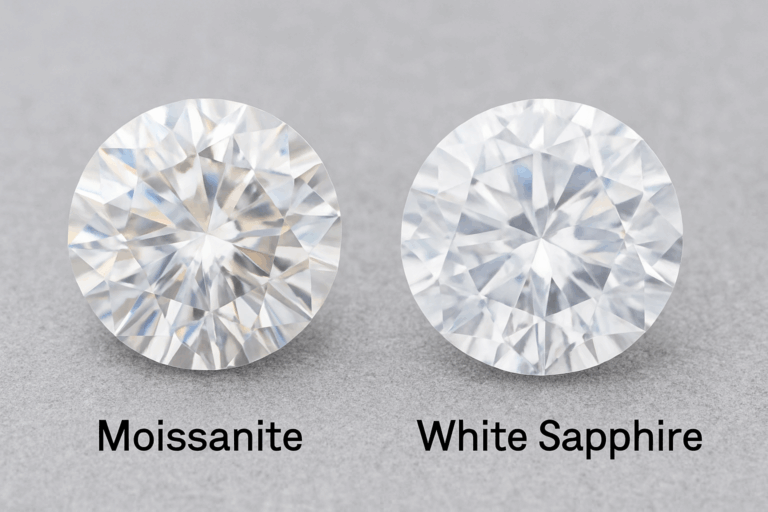
Moissanite vs White Sapphire
Sparkle and Fire
Moissanite
Moissanite is known for its lively sparkle and the intense flashes of color it produces, commonly referred to as moissanite fire. This natural dispersion gives the stone a radiant, eye-catching brilliance that rivals traditional diamonds in jewelry.
White Sapphire
The white sapphire gem offers a more subtle shine. Its sparkle is elegant and clear, but it lacks the colorful flashes of moissanite, resulting in a softer, understated brilliance that appeals to those who prefer a classic look.
Durability and Hardness
Moissanite
Moissanite ranks about 9.25 on the Mohs scale, giving it excellent resistance to scratches and making it ideal for everyday wear. Its durability ensures the stone retains its polished look over time, which is why it is a popular choice for engagement rings and wedding bands.
White Sapphire
The hardness of white sapphire is around 9, making it very durable but slightly more prone to minor scratches than moissanite. In a moissanite vs white sapphire comparison, moissanite generally provides superior scratch resistance and long-term toughness, while white sapphire remains a classic and reliable choice for jewelry.
Value and Affordability
Moissanite
Moissanite is prized for its impressive sparkle and durability at a relatively affordable price. The value of moissanite lies in its ability to mimic the brilliance of diamonds while offering a more budget-friendly option, making it a popular choice for engagement rings and wedding bands.
White Sapphire
White sapphire is generally less expensive than diamonds but can vary depending on clarity and origin. The worth of white sapphire comes from its rarity, traditional appeal, and long-lasting durability, offering a classic, elegant option for fine jewelry.
Symbolism and Meaning
Moissanite
Moissanite symbolizes lasting love, commitment, and resilience, reflecting its durability and fiery brilliance. Its modern, ethical sourcing also makes it meaningful for couples who value sustainability and conscious choices.
White Sapphire
White sapphire represents wisdom, purity, and loyalty, carrying a classic and timeless symbolism. Its understated sparkle and traditional appeal make it a popular choice for those who appreciate elegance and heritage in jewelry.
Longevity and Everyday Wear
Moissanite
Moissanite is extremely durable and scratch-resistant, capable of withstanding daily wear for decades. With proper care, a moissanite stone can last a lifetime, retaining its brilliance and polished appearance, making it an ideal choice for wedding jewelry meant to endure a lifetime of use.
Also Read: Do Moissanite Rings Last Like Diamonds? Expert Insights On Longevity
White Sapphire
White sapphire is also durable for everyday jewelry, though it is slightly more prone to minor scratches over time. With routine care, it can remain beautiful for many years, offering a classic and reliable option for long-term wear.
Color Options
Moissanite
The colors of moissanite range from colorless white moissanite to near-colorless, often showing subtle yellow, green, or gray undertones depending on light and angle. Advanced lab technology has introduced more moissanite colors, including pink, blue, and green options that appeal to modern tastes. This versatility allows couples to match their moissanite to their personality or fashion sense with ease.
White Sapphire
White sapphire is traditionally colorless, offering a clean and elegant appearance that many associate with classic bridal jewelry. However, while the white sapphire gem itself does not come in other hues, sapphires as a family exist in a wide range of colors—such as blue, pink, yellow, and green—making them one of the most diverse gemstone groups in fine jewelry.
Also Read: How Many Types Of Moissanites Do You Know
Clarity
Moissanite
Moissanite is prized for its exceptional transparency and internal purity, often receiving top ratings on the moissanite clarity scale. Thanks to its lab-created origin, moissanite clarity remains remarkably high, with minimal inclusions or imperfections. This allows light to pass through cleanly, giving the gemstone its signature brilliance and fire that closely resemble diamond’s radiance.
White Sapphire
White sapphires are naturally formed gemstones that may show subtle inclusions, slightly softening their sparkle. Lab-created white sapphires offer improved clarity and more consistent quality. Comparing the two, in a moissanite vs white sapphire perspective, moissanite generally provides a cleaner, near-flawless appearance, while white sapphire maintains a softer, more understated luster that appeals to those who favor a classic look.
Environmental and Ethical Factors
Moissanite
As a lab-grown gemstone, moissanite has a minimal environmental footprint and no connection to mining. Its controlled production process ensures ethical sourcing, traceable origins, and consistent quality. This makes moissanite an appealing option for eco-conscious couples seeking a sustainable alternative to traditionally mined stones.
White Sapphire
White sapphires, whether natural or lab-created, vary in their environmental and ethical impact. Natural sapphires require mining, which can affect ecosystems depending on extraction practices, while lab-grown versions offer a more sustainable alternative. Choosing a responsibly sourced white sapphire gem allows buyers to enjoy beauty with a clear conscience.
Jewelry Design and Setting Compatibility
Moissanite
Moissanite’s durability and brilliance make it highly versatile for various jewelry designs. It works well with prong, bezel, and halo settings, allowing moissanite engagement rings to showcase the stone’s fire and sparkle in both classic and modern styles.
White Sapphire
White sapphires are slightly softer than moissanite but still durable enough for most settings. A white sapphire ring pairs well with prong or bezel designs, providing a timeless and elegant look, though care should be taken to avoid overly delicate settings that may risk chipping.
Maintenance and Care
Moissanite
Moissanite is low-maintenance thanks to its hardness and durability. Regular gentle cleaning with warm soapy water and a soft brush keeps the stone sparkling. Its resistance to scratches and tarnish makes it suitable for everyday wear without frequent professional upkeep.
White Sapphire
White sapphires require a bit more care to maintain their brilliance. While durable, they can develop minor surface scratches over time. Cleaning with mild soap, warm water, and a soft brush, along with occasional professional polishing, helps preserve the gem’s clarity and shine.
Pros and Cons
Pros of Moissanite
- Exceptional brilliance and fire
- High durability and scratch resistance
- Lab-created, ethically sourced, and eco-friendly
- Suitable for a wide range of ring designs
Cons of Moissanite
- Slightly softer than diamond
Pros of White Sapphire
- Durable and suitable for everyday wear
- Natural and lab-created options available
Cons of White Sapphire
- Natural stones may contain inclusions
Requires occasional polishing to maintain shin
Quick Comparison Table
Feature Moissanite White Sapphire
Brilliance and Fire Exceptional sparkle and fire, closely resembles diamond Moderate sparkle, more subtle glow
Hardness and Durability Mohs 9.25, very scratch-resistant Mohs 9, durable but softer than moissanite
Value and Cost Affordable yet high-quality, great long-term value Slightly less expensive for natural stones, lab-created versions cost more
Symbolism and Meaning Represents love, commitment, and modern elegance Represents sincerity, wisdom, and timeless elegance
Longevity Can last a lifetime with minimal care Long-lasting, but may require occasional polishing
Color Options Multiple colors including colorless, pink, blue, green Primarily colorless; sapphires in other hues available but not typical for engagement rings
Clarity Near-flawless, high ratings on moissanite clarity scale May contain minor inclusions; lab-created improves clarity
Ethical Factors Lab-grown, eco-friendly, ethical sourcing Natural stones mined; lab-created options offer sustainability
Setting Compatibility Works with prong, bezel, halo, and custom designs Suitable for prong and bezel; delicate settings need caution
Maintenance Low-maintenance, easy to clean, resistant to scratches Requires gentle cleaning; occasional professional polishing recommended
Pros and Cons Pros: Brilliant, durable, ethical; Cons: Slightly softer than diamond Pros: Durable, classic, natural or lab options; Cons: Less brilliance, may show inclusions

White Sapphire vs Moissanite vs Diamond
As one of the most classic gemstones, many people find themselves wondering which to choose among white sapphire, moissanite, and diamond. Each offers unique qualities: moissanite dazzles with brilliant sparkle and durability, white sapphire provides a subtle, elegant shine with strong scratch resistance, and diamond remains the timeless favorite for its unmatched brilliance and long-lasting value.
How to Choose Your Right Gemstone
Not all gemstones are created equal. Comparing moissanite vs white sapphire shows clear differences: moissanite dazzles with unmatched sparkle and toughness, while white sapphire offers a clean, elegant look and strong scratch resistance. If you want a gemstone that truly shines, moissanite is the better choice.
Conclusion
When deciding between moissanite vs white sapphire, it ultimately comes down to what matters most to you. Moissanite stands out for its brilliance and durability, making it perfect for those who want their jewelry to sparkle every day. White sapphire, on the other hand, offers a more understated elegance and excellent scratch resistance.
FAQs About Moissanite vs White Sapphire
What is the main difference in sparkle between moissanite and white sapphire?
In the moissanite vs white sapphire comparison, moissanite shows stronger brilliance and fire, while white sapphire offers a softer, more subtle glow. Moissanite tends to look more lively under different lighting conditions.
Moissanite vs white sapphire, which gemstone is more durable for everyday wear?
Moissanite is harder and more resistant to scratches, making it better for daily use. White sapphire is durable but may show surface wear faster over time.
Is white sapphire real and is a white sapphire a diamond?
Yes, white sapphire is a real gemstone, but it is not a diamond; the main difference between white sapphire and diamond lies in brilliance, hardness, and price.
Does white sapphire look like a diamond?
Yes, white sapphire can resemble a diamond, though it has slightly less brilliance and fire.
Are white sapphires valuable?
Yes, white sapphires have value as gemstones.
Are sapphires cheaper than diamonds?
Yes, sapphires are generally more affordable than diamonds, making them a cost-effective alternative.
Is white sapphire expensive? How much is white sapphire worth?
White sapphire is usually less expensive than diamonds, with value depending on size, clarity, and cut.
Is white sapphire good for engagement rings?
Yes, white sapphire is durable and elegant, making it a popular choice for engagement rings.
Lab created sapphire vs real sapphire – what are the differences?
Lab-created sapphires are chemically identical to natural ones but are usually more affordable and ethically sourced.
How much does moissanite cost?
Moissanite cost varies by size and quality, with lab created moissanite price generally much lower than natural diamonds, making it an affordable sparkling alternative.
What colors does moissanite come in? Does moissanite come in different colors?
Moissanite comes in colorless, near-colorless, and fancy shades, providing a variety of options for jewelry.

